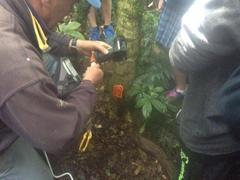High hopes for Forest Hill Reserve
Karen Brown
04 April 2019, 1:28 AM
 A group of Lochiel School students, who are working with the Forest Hill Foundation Trust, recently set some pest traps which they will monitor over the coming months. PHOTO: Supplied
A group of Lochiel School students, who are working with the Forest Hill Foundation Trust, recently set some pest traps which they will monitor over the coming months. PHOTO: SuppliedA fenced bird sanctuary is the dream of a trust set up by Forest Hill landowners for the 50ha Northern Outlier Reserve of the Forest Hill Scenic Reserve near Browns.
Forest Hill Foundation Trust deputy chairman Ralph Hamilton said the ultimate goal was to introduce kiwi to the reserve, which was already home to bellbirds, tui, pigeons and fantails.
He said other species of rarer birds to be re-introduced in to the proposed sanctuary would be tomtits and moreporks.
The success of the project would depend on the enthusiasm of the voluntary Forest Hill Foundation Trust Committee to maintain a predator-proof fence, which would cost $1 million to build.
"The existing bird population at the main 500ha Forest Hill Reserve would explode if the sanctuary went ahead," Mr Hamilton said.
He remembers when he was a child 60 years ago there were always wood pigeons in the garden on the 150-year-old family farm about 2km from the reserve.
"The kowhai trees on the edge of the bush would have 20 to 30 wood pigeons in them."
Two hundred self-setting predator control traps have been set up in the reserve but Mr Hamilton said as many as 700 more were required and the trust was seeking funding to increase the network of self-setting traps to 900 in the main reserve to protect the bird population.
The 700 traps could cost as much as $115,500 but Mr Hamilton estimated $100,000 had already been spent on predator control over the last few years contracting licensed 1080 poison operators who monitored the bait stations.
An appeal to visitors to help fund the self-setting traps – which Mr Hamilton said were a "huge time-saver" for volunteers because they only needed to be checked twice a year – was made through leaflets left at both the Forest Hill and Tussock Creek entrances to the Derek Turnbull Track which goes across the reserve.
However, funding may have to be sourced through DOC, private supporters and public funding, because of the lack of response to the appeal, Mr Hamilton said.
This was despite monitors on the reserve's access roads at Forest Hill and Tussock Creek counting 1200 vehicles over a period of two months.
"People use the walking tracks all the time," Mr Hamilton said.
The first 200 traps were bought by Winton community groups and individuals and businesses while Lochiel School students have also been involved setting up traps and monitoring tunnels.
The 13km boundary line of the reserve has also been serviced by DOC spring-operated box traps for stoats, ferrets and rats.
Stoats, in particular, could move very quickly and cover long distances and were a threat because they climbed trees to reach the eggs from nests.
It's not just trapping being carried out to protect and enhance the reserve. Spraying has been carried out on isolated outbreaks of a foreign invader in the form of the Chilean Flame Creeper, a weed that can smother the tree canopy.
DOC staff are confident they can control the weed found at three locations in the reserve, one of which was well established.
A private contractor employed by the voluntary Forest Hill Foundation Trust, discovered the weed when she was doing a native bird count of wood pigeons, tuis, bellbirds and fantails.
The birds eat the small purple berries the weed produces and spread the seed. The creeper, which has a bright red flower, spreads by growing underground tubers and is hard to kill. It is cut off the tree it grows up and requires repeated sprays on the ground. Larger outbreaks of the creeper have been found on other reserves around Southland but it is hoped the few sites at Forest Hill will be easier to control.
Other unwanted vegetation found at the reserve includes elderberry, blackberry, and hawthorn bushes.